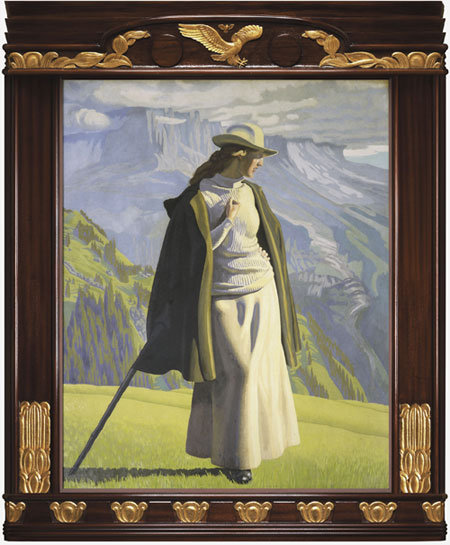From Symbolism to Expressionism
dal 26/6/2006 al 16/9/2006
Segnalato da
26/6/2006
From Symbolism to Expressionism
Musee d'Orsay, Paris
Willumsen (1863-1958). His works were shown in the "Salons", at Le Barc de Boutteville's as well as at the Universal Exposition in 1900, which kept one of his creations, a masterpiece of Symbolist painting. Later the artist developed a vision based on the luminous force of colour. The exhibition has grouped some 30 paintings, nearly 10 prints, as many ceramics as well as some 40 photographs.

Willumsen (1863-1958)
The Orsay Museum did not undertake an easy task when it decided to show Willumsen’s work. Besides the fact that the artist’s very long career goes many decades beyond the chronological limits imposed on the museum, his work is multiform. Putting aside painting, he was interested in sculpture, architecture, ceramics and he practiced engraving and photography. His deeply individualistic, mobile and assimilating personality makes it difficult to approach his work, and holds many surprises. To try to figure him out the exhibition has grouped together some thirty paintings, nearly ten prints, as many ceramics as well as some forty photographs
A Dane in France
Jens Ferdinand Willumsen, born in Copenhaguen in 1863, spent a major part of his life in France. Even during his artistic training in Copenhaguen, he spent many long periods in Paris. His works were shown in the "Salons", at Le Barc de Boutteville’s as well as at the Universal Exposition in 1900, which kept one of his creations, a masterpiece of Symbolist painting: Jotunheim (Frederikssund, J.F. Willumsens Museum). Following an additional trip to Copenhaguen - where he stayed from 1897 to 1900 as artistic director of the Bing & Grondhal porcelain factory - and a number of trips to the United States, Italy, Switzerland, Norway, Spain and North Africa, he settled in Southern France in 916 (Villefranche, Nice, Cannes, Le Cannet). He only returned occasionally to Denmark. But he continued nevertheless to exhibit there regularly and to receive private and public commissions from his native country. He died at Cannet in 1958, leaving his companion, French dancer Michelle Bourret whom he had lived with since 1928 after his two legitimate wives, Juliette Meyer and Edith Wessel each bore him two children.
A rather Northern than Latin Symbolism
He was initially marked by Raffaelli’s Naturalism. Later Willumsen was in contact with the Parisian avant-gard circles in the 1890s and his painting, first influenced by Gauguin and the Nabis - in particular by Vallotton Scene of the quais in Paris, 1890, Frederikssund, Willumsens Museum - is cloisonne' and a product of synthetism. The rhythm of his compositions, based on a solid and simplifying trait, a flexible layout of lines and colours, grants them a decorative character. But the artist quickly put a distance between himself and French symbolism, to then turn towards a world of more Northern than Latin expression. The expressionnist power, nourished by the discovery in 1900 of the immense spaces of the New World, and which is conveyed trough his large paintings representing mountains, irresistibly refers to Munch and Hodler. This nature, often hostil and threatening, even in its beauty, imposes itself as the creative force of all life. The man of the new century can nevertheless dominate it sometimes. This is the sense of his large "modern" allegory A mountaineer (1904). On the other hand, his large canvas over four metres long, Children bathing on the beach of Skagen (1909, Frederikssund, Willumsens Museum), is a hymn to the joy of living, an exceptional moment of fusion not only between man and nature, but between the Northern and Mediterranean worlds.
The luminous force of colour
In the years 1910, the artist developed a vision based on the luminous force of colour. Following various stays in Spain, in 1910, 1911 and 1912, he discovered El Greco and dedicated a book to him, published in France in 1927. In Sophus Claussen reading his poem "Imperia" to Helge Rode and Willumsen (1915, Aarhus, Kunstmuseum) and The evening soup (1918, Frederikssund, Willumsens Museum), the heavy atmosphere is the result of the intensity of the colours and the expressionist deformities of the silhouettes, thus revealing the new stylistic orientation followed by the painter. This temper, passionate but not void of sarcastic humour, is also ironical about the creative power contradicted by the responsibility for people’s welfare and a faltering inspiration, as is shown in the two paintings with a saturated red background, The painter and his family (1912, Stockholm, National Museum) and Selfportrait in painter’s blouse, executed in Nice in 1933 (Frederikssund, Willumsens Museum).
PUBLICATION
Exhibition catalogue 21 x 25 cm, 272 p., 172 col, ill., paper cover, e'ditions RMN, diffusion Interforum, 45 euros
Media partners: Paris Premie're, France Culture
Orsay Museum
1, rue de la Legion d'Honneur
OPENING HOURS:
Every day, from 9:30 AM to 6 PM,
Thursday until 9:45 PM
Closed on Monday.
PRICES OF ADMISSION:
Museum+Exhibition: Full rate: 7,50€
Concessions and sunday: 5,50€
Free admissions: under 18, and holders Carte blanche du muse'e d'Orsay, Muse'O, La Carte jeune du muse'e d'Orsay



